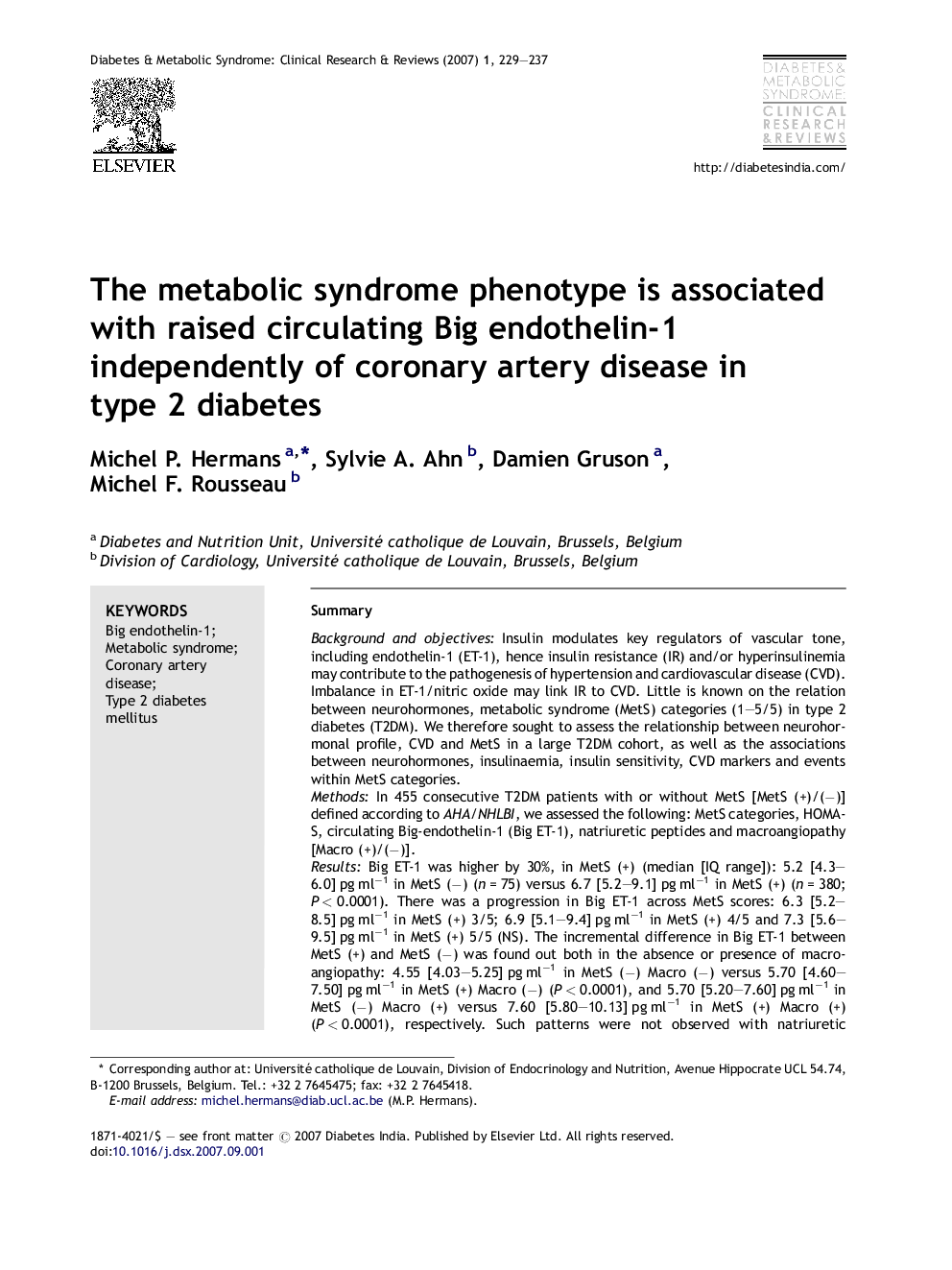| کد مقاله | کد نشریه | سال انتشار | مقاله انگلیسی | نسخه تمام متن |
|---|---|---|---|---|
| 2910175 | 1174609 | 2007 | 9 صفحه PDF | دانلود رایگان |

SummaryBackground and objectivesInsulin modulates key regulators of vascular tone, including endothelin-1 (ET-1), hence insulin resistance (IR) and/or hyperinsulinemia may contribute to the pathogenesis of hypertension and cardiovascular disease (CVD). Imbalance in ET-1/nitric oxide may link IR to CVD. Little is known on the relation between neurohormones, metabolic syndrome (MetS) categories (1–5/5) in type 2 diabetes (T2DM). We therefore sought to assess the relationship between neurohormonal profile, CVD and MetS in a large T2DM cohort, as well as the associations between neurohormones, insulinaemia, insulin sensitivity, CVD markers and events within MetS categories.MethodsIn 455 consecutive T2DM patients with or without MetS [MetS (+)/(−)] defined according to AHA/NHLBI, we assessed the following: MetS categories, HOMA-S, circulating Big-endothelin-1 (Big ET-1), natriuretic peptides and macroangiopathy [Macro (+)/(−)].ResultsBig ET-1 was higher by 30%, in MetS (+) (median [IQ range]): 5.2 [4.3–6.0] pg ml−1 in MetS (−) (n = 75) versus 6.7 [5.2–9.1] pg ml−1 in MetS (+) (n = 380; P < 0.0001). There was a progression in Big ET-1 across MetS scores: 6.3 [5.2–8.5] pg ml−1 in MetS (+) 3/5; 6.9 [5.1–9.4] pg ml−1 in MetS (+) 4/5 and 7.3 [5.6–9.5] pg ml−1 in MetS (+) 5/5 (NS). The incremental difference in Big ET-1 between MetS (+) and MetS (−) was found out both in the absence or presence of macroangiopathy: 4.55 [4.03–5.25] pg ml−1 in MetS (−) Macro (−) versus 5.70 [4.60–7.50] pg ml−1 in MetS (+) Macro (−) (P < 0.0001), and 5.70 [5.20–7.60] pg ml−1 in MetS (−) Macro (+) versus 7.60 [5.80–10.13] pg ml−1 in MetS (+) Macro (+) (P < 0.0001), respectively. Such patterns were not observed with natriuretic peptides. Comparison between MetS (+) Macro (−) versus MetS (−) Macro (+) confirms that such incremental differences should not be solely ascribed to parallel shifts in IR and/or compensatory hyperinsulinaemia.ConclusionsBig ET-1 is raised in T2DM patients with MetS, and its level proceeds stepwise to MetS categories. Elevated Big ET-1 is present in all categories of MetS patients, with or without macroangiopathy. The ascent in Big ET-1 found in MetS (+) without macrovascular disease is of the same magnitude as that conferred by the presence of macroangiopathy.
Journal: Diabetes & Metabolic Syndrome: Clinical Research & Reviews - Volume 1, Issue 4, December 2007, Pages 229–237